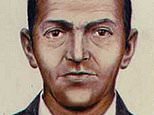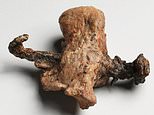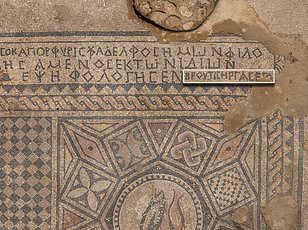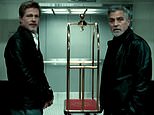Revealed: The 7 most astonishing pieces of evidence that Jesus left behind
As the Bible tells it, 2024 years ago a man named Jesus was born in a little-known town on the edge of the Roman Empire and was killed 33 years later.
But do we really have any reason to believe this is more than just a story?
Perhaps surprisingly, experts say we do have extremely compelling evidence to support the story recounted by the gospels.
From the plethora of contemporary sources to the graffiti mocking his followers, Jesus' life left an indelible mark on the historical record.
Likewise, archaeologists working in Palestine and Israel have uncovered a number of artefacts supporting the basic facts of Jesus' life as described in the Bible.
And, while there is no conclusive physical evidence, experts say this is exactly what we would expect for someone of Jesus' status in society.
Dr Lawrence Mykytiuk, a specialist in Hebrew studies from Purdue University, told MailOnline: 'We have many very good reasons to accept the real, historical existence of Jesus of Nazareth.'
Here's the seven most astonishing pieces of evidence that Jesus left behind.

Despite having lived a short life as an impoverished peasant over 2,000 years ago, experts say there is overwhelming evidence that Jesus was a real historical figure
1: Written evidence
The best reason we have to believe in the existence of the historical Jesus is that there surprisingly good written records about his life.
What makes this so compelling is that many of the accounts are written by non-Christian authors who were often openly opposed to Christianity.
Dr Mykytiuk says: 'For well over 1,000 years, no one claimed that Jesus did not exist.
'Every single non-Christian source from ancient times recognizes, implicitly or explicitly, that he was a real person who really existed.'
Possibly the best example of this comes from the Roman historian Tacitus who despised Christians.
In a section of the 'Annals' describing the AD 64 fire of Rome, Tacitus describes how Emperor Nero tried to shift the blame to early Christians.
Tacitus writes: 'Nero substituted as culprits and punished in the most unusual ways those hated for their shameful acts … whom the crowd called “Chrestians.”

Flavius Josephus (pictured) was a Jewish historian who wrote about 60 years after Jesus' death. In his history of the Jewish people he mentions 'the brother of Jesus-who-is-called-Messiah, James by name'
'The founder of this name, Christ, had been executed in the reign of Tiberius by the procurator Pontius Pilate.'
Likewise, the Jewish author Flavius Josephus mentions Jesus in his sprawling 'Jewish Antiquities' which was written just 60 years after Jesus' death.
In a section of the book, Josephus describes how a priest named Ananus tried to execute Jesus' brother, James.
He writes that Ananus 'called a meeting of judges and brought into it the brother of Jesus-who-is-called-Messiah, James by name.'
What makes this so interesting is that James, or Jacob as it would have been written, was such a common name that Josephus felt the need to specify by mentioning Jesus.
Dr Mykytiuk says: 'If Jesus, James’s brother, had not been a real person, this reference to Jesus-who-is-called-Messiah would have made no sense.'
2: The Alexamenos Graffito
Once we go beyond the written records, physical evidence of Jesus' existence becomes significantly harder to find.

This crude graffiti carved into a wall of the Palatine Hill in Rome is possibly the first depiction of Christians anywhere in the world
As researchers have noted, we don't have records for 99 per cent of the people who served in the Roman Empire.
This makes it astronomically unlikely that there would be any trace of a man who lived in poverty and met the fate of a common criminal.
However, there are some artefacts from the early days of the Church which do offer compelling evidence.
Surprisingly, one of the best real pieces of evidence we have for the existence of Jesus is a crude and rather abusive piece of ancient graffiti.
Known as the Alexamenos Graffitto, this was a crude drawing scratched into the wall of a room near the Palatine Hill in Rome somewhere between the first and third century AD.
The drawing depicts a man worshipping a donkey-headed man hanging from the cross with a message that translates to: 'Alexamenos worships [his] god.'
Dr Jonathan Reed, a leading authority on the archaeology of early Christianity from the University of La Verne, told MailOnline: 'The earliest evidence we have in the archaeological record for Christians is someone making fun of Jesus being crucified.'
The reason this is so convincing is that it passes what Dr Reed calls describes as 'the criterion of embarrassment'.
![The Alexamenos Graffito shows a Christian worshipping a donkey-headed Jesus with the inscription 'Alexamenos worships [his] god'. Experts say this mocking depiction of Christ is good evidence that the embarrassing features of his death actually occurred and were well-known between the first and third centuries. Pictured, a tracing of Alexamenos Graffito](https://i.dailymail.co.uk/1s/2024/11/23/15/92379589-14105531-The_Alexamenos_Graffito_shows_a_Christian_worshipping_a_donkey_h-a-4_1732375884002.jpg)
The Alexamenos Graffito shows a Christian worshipping a donkey-headed Jesus with the inscription 'Alexamenos worships [his] god'. Experts say this mocking depiction of Christ is good evidence that the embarrassing features of his death actually occurred and were well-known between the first and third centuries. Pictured, a tracing of Alexamenos Graffito
Dr Reed says: 'The crucifixion would have been seen as shameful and much of the Gospels are about trying to make the crucifixion into a heroic death.'
Similarly, the fact that Jesus is presented initially as a follower of John the Baptist was deeply troubling to the early church and something that a lot of effort was spent trying to explain.
The fact that embarrassing details survived and that Christians were so distressed by them is actually a good sign that they weren't made up.
Dr Reed says: 'From my perspective, what I would be most certain of is that Jesus started off as a follower of John the Baptist, that he was from the lower peasant classes, maybe he was an illegitimate child, and that he was crucified.'
3: The Crucified heel
Another detail of the crucifixion that some scholars have found hard to explain is: If Jesus died an enemy of the state, why was he permitted a full burial?
Although there is plenty of evidence that the crucifixion really happened, some critics argue that Jesus would more likely have been thrown in a mass grave for criminals.
However, in 1986 a construction crew accidentally uncovered several tombs in Northern Jerusalem.

The crucified heel of a man named Jehohanan was found in a tomb in Israel. This proves that Jesus could have received a proper burial as the Gospel claims rather than being thrown into a mass burial pit for criminals
One ossuary, a chest for holding skeletal remains, was marked with the name Jehohanan and contained the remains of a man who appeared to have been crucified.
The bones included a heel which still had the nail embedded in it from where the man had been pinned to the cross.
Not only does this further support that the description of Jesus' nailing to the cross is accurate, but it also shows that families could retrieve the remains of crucified criminals.
While not a direct piece of evidence for Jesus' life, this discovery vindicated the Gospel writer's account of his death.
4: The Shroud of Turin
Of course, there couldn't be a discussion of evidence for Jesus' life without some mention of the holy relics.
The most famous of all the objects supposedly associated with Jesus is the Shroud of Turin.
This is a piece of cloth bearing an imprint of a man which is considered by many to be the cloth Jesus was wrapped in after the crucifixion.

The Shroud of Turin features the image of a man with sunken eyes, which experts have analysed under different filters to study it (pictured)
Unfortunately, the evidence surrounding the reality of the shroud is highly contentious.
Some scholars are convinced that this is a legitimate relic of Jesus but there is a growing body of evidence mounting against that position.
For example, a recent study found that the distinctive image marked on the shroud could not have been made by a human body but must have been made by shallow carving.
Likewise, a study conducted by the Italian researcher Antonio Lombati found that the weave pattern used for the shroud doesn't match any examples of grave linens from Israel and Palestine dated to Jesus' time.
Rather, the pattern is extremely similar to cloth produced in the early Middle Ages during the Crusades – the period to which the shroud was dated during research in the 1980s.
Dr Reed says: 'I'm convinced that they [the holy relics] are all forgeries and that's partly to do with the fact that they all pop up at the same time after the Crusades when there was a thirst for this stuff in Europe.
'If you look at the Shroud of Turin, early on, even in the Church documents, there was some suspicion of it.
However, some researchers remain still convinced of the shroud's veracity.

A recent study concludes that the impression on the shroud could not have been made by a three-dimensional human body, but was perhaps from a bas-relief - a shallow carving (top)
Dr Ben Witherington III, a Bible scholar at the Asbury Theological Seminary, told MailOnline: 'The shroud itself has a negative image on it of a crucified man, which existed at least as early as the early Middle Ages, in an age long before photographs.
'How exactly did that image get on the cloth, and how does it represent so accurately where Jesus would have been flagellated on his back, or nailed in his wrists, or bleed from the head due to something- say a thorny crown?'
5: The Church of the Apostles
In 2017, archaeologists digging in the area of El Araj, Israel made a surprising discovery.
Buried next to the River Jordan the archaeologists found the remains of a Byzantine basilica measuring 27m by 15m (88ft by 52ft).
Researchers believe that this may be the site of Bethsaida, the village which was home to the apostles Peter, Andrew, and Phillip.
If that were the case, this would make the El Araj basilica the lost 'Church of the Apostles which was supposedly built over the village's ruins.
Following further investigations in 2021, Professor Steven Notely, an archaeologist from Nyack College and co-director of the dig, told the Biblical Archaeology Society: 'There are no other churches in the vicinity mentioned by Byzantine visitors to the Holy Land, and there is no reason to question that this is the [Church of the Apostles].'

This mosaic was found in a basilica believed to be the Church of the Apostles, built above the homes of Peter, Andrew, and Phillip. However, how much evidence this provides for the existence of the historical Jesus is debated
Even more interestingly, excavations found the remains of a Roman-era fishing village beneath the later church.
For some, this provides a compelling case that the Biblical account of Jesus' life is backed up by hard evidence.
Dr Reed says: 'I've excavated many of the places mentioned in the Bible and the Gospels describe them all with a certain level of accuracy.'
However, Dr Reed also points out that this doesn't necessarily tell us much about the figure of Jesus.
'If you really push me, I'd say it's not even proof that Jesus existed,' says Dr Reed.
Likewise, Dr Mykytiuk says that these findings show that the Bible is broadly correct about historical context.
He adds: 'This support is so indirect that it has almost no effect regarding Jesus’s existence - except perhaps to whet the appetite of researchers.'
6: The 'Jesus is God' inscription

This 1,800-year-old mosaic contains the ancient Greek phrase: 'The god-loving Akeptous has offered the table to God Jesus Christ as a memorial.' This is the first recorded mention of the divinity of Christ
Just like the Alexamenos Graffito, evidence from the early church gives us a strong indication that there really was a person for the followers to unite around.
Another slightly more flattering example of this is an inscription found beneath the floor of an Israeli prison.
This 1,800 year-old-mosaic features the first written declaration of Jesus as a God.
The 581-square-foot mosaic decorated the world's first prayer hall in 230 AD and contains the ancient Greek phrase: 'The god-loving Akeptous has offered the table to God Jesus Christ as a memorial.'
Carlos Campo, CEO of the Museum of the Bible which recently exhibited the mosaic, hailed it as 'the greatest discovery since the Dead Sea Scrolls'.
This shows that the divinity of Christ became part of some Christians' ideologies as little as 200 years after his death.
However, leading Biblical historian Bart Ehrman claims that this was not a view shared by all of the earliest Christians.
Dr Reed says: 'As early as the first century there was a competition to talk about who Jesus really was and what is the significance of the Christ figure.

Experts say that the existence of conflicting views of Jesus and the widespread discussion of his divinity in places like the Megiddo Mosaic (pictured) suggests that there was a real figure that the early church was reacting to
'Because you have these disagreements, I just don't buy the theory that there was a conspiracy to fabricate this person.
'If there was a conspiracy, it was the most disorganised, chaotic, contradictory attempt imaginable.'
7: The James ossuary
The so-called 'James Ossuary' is a bone box bearing the Aramaic inscription: 'James, son of Joseph, brother of Jesus.'
Dr Witherington says: 'The likelihood of that particular combination of those three names not referring to the famous James the Just, and his father Joseph, and his brother Jesus are slim to none.
'If it were true that the crucifixion was the end of Jesus' story, no one would be bragging about being related to him on an ossuary.'
If the James Ossuary is real, it would indeed be a striking piece of evidence that Jesus was a real figure who became important shortly after his death.
Unfortunately, the story of the James Ossuary is a little more complicated.

The so-called James Ossuary is a box believed to contain the remains of James, the brother of Jesus. However, the box's veracity has been a matter of fierce debate and even legal action
The ossuary was allegedly acquired by an Israeli businessman named Oded Golan from an unknown antique dealer in the 1970s.
However, in an unusual move, the Israel Antiquities Authority (IAA) accused Mr Golan of faking the relic and took him to court in the 'the forgery trial of the century'.
Experts from the IAA alleged that Mr Golan had taken a real first-century ossuary and added the inscription himself.
When police took Mr Golan into custody they did indeed find a forgery lab filled with tools and half-finished 'antiquities'.
But, in another twist, Mr Golan was then acquitted of all charges of forgery in 2012 on the grounds that the IAA had not proven the inscription was fake.
During the trial, it emerged that some of the IAA's experts didn't have the proper specialisms to properly appraise whether or not the writing was real.
For many, this vindicated the James Ossuary as a brilliant piece of evidence for the historicity of Jesus.
However, as is so often the case, not all academics agree that the James Ossuary has also been exonerated.

The original owner of the James Ossuary was charged with forgery. Although he was later acquitted some experts still question the suspicious circumstances in which the artefact came to light. Pictured at the Royal Ontario Museum, Canada, 2002
Dr Reed says that just because Mr Golan was acquitted doesn't mean the ossuary is real.
'I'm a big believer in archaeology finding things in situ, if it pops up on the black market we can't be sure where it was found and we be sure whether it has been doctored,' Dr Reed says.
'We have pretty good evidence that part of the inscription was doctored and it was found in a person's home who had forging equipment.
'I think there's so much fishiness that we can't include it in the historical record.'



































































































































































































































































































































